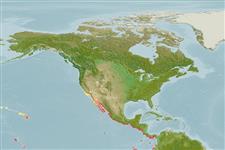Common names from other countries
Environment: milieu / climate zone / depth range / distribution range
экология
морской; пресноводный; солоноватоводный демерсальный; pH range: 7.5 - 9.5; амфидромный (Ref. 51243); пределы глубины 1 - ? m. Subtropical; 25°C - 33°C (Ref. 36880); 41°N - 0°S
Eastern Pacific: Palos Verdes in southern California, USA to Peru.
Length at first maturity / Size / Вес / Возраст
Maturity: Lm ?, range 17 - ? cm
Max length : 41.0 cm TL самец/пол неопределен; (Ref. 5404); 39.0 cm TL (female); common length : 25.0 cm TL самец/пол неопределен; (Ref. 55763); наибольший вес (опубликованные данные): 1.2 kg (Ref. 5404); наибольший вес (опубликованные данные): 1.2 kg
Краткое описание
определительные ключи | морфология | морфометрия
Body compressed; head flat; first dorsal fin with 7 spines, second with 1 spine and 8 to 9 rays; anal fin with 1 spine and 9 to 10 rays; lateral line with 30 to 34 scales; body depth contained about three times in standard length; body dark green to dark brown with numerous small pale spots (Ref. 55763).
Facultative air-breathing (Ref. 126274); Inhabit estuaries, stagnant ditches or creeks of low current velocity between the sea and an elevation of 30 m. Benthic and most abundant on sandy and muddy bottoms. Ingests much mud and detritus, although also filter plankton (Ref. 36880). Found in shallow inshore areas; typically in freshwater but moves freely into the sea.
Life cycle and mating behavior
Maturities | размножение | Spawnings | Egg(s) | Fecundities | личинки
Eschmeyer, W.N., E.S. Herald and H. Hammann, 1983. A field guide to Pacific coast fishes of North America. Boston (MA, USA): Houghton Mifflin Company. xii+336 p. (Ref. 2850)
Статус Красного Списка МСОП (Ref. 130435)
CITES (Ref. 128078)
Not Evaluated
Угроза для людей
Harmless
Использование человеком
рыболовство: коммерческий; аквакультура (рыбоводство): коммерческий
дополнительная информация
инструменты
Специальные отчеты
Скачать в формате XML
ресурсы в Интернет
Estimates based on models
Preferred temperature (Ref.
115969): 22.3 - 29.1, mean 26.8 (based on 208 cells).
Phylogenetic diversity index (Ref.
82804): PD
50 = 0.5312 [Uniqueness, from 0.5 = low to 2.0 = high].
Bayesian length-weight: a=0.01072 (0.00781 - 0.01470), b=3.11 (3.02 - 3.20), in cm Total Length, based on LWR estimates for this species (Ref.
93245).
Trophic level (Ref.
69278): 2.0 ±0.0 se; based on diet studies.
устойчивость к внешним воздействиям (Ref.
120179): высокий, минимальное время удвоения популяции до 15 месяцев (K=0.57).
Fishing Vulnerability (Ref.
59153): Low to moderate vulnerability (25 of 100).
